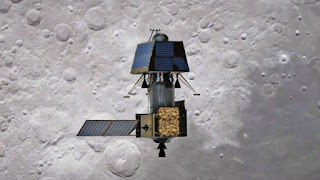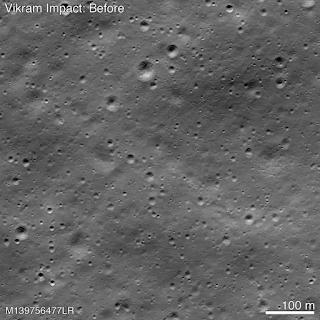THE GLOBAL EXPRESS
A modest brilliant bit, a white spot on the huge lunar canvas very like a needle in a bundle offered the main hint to the destiny of Vikram, a small rocket India had would have liked to arrive on the Moon as a major aspect of the Chandrayaan-2 strategic. Vikram housed the six-wheeled robot Pragyaan and conveyed an aggressive fantasy about putting a wanderer on the lunar surface. Nonetheless, Vikram went quiet during its September 7 landing endeavour on the Moon and was never gotten notification from since.
Vikram has now been found. Because of the endeavours of 33-year-old Chennai nerd Shanmuga Subramanian, who carefully searched through photographs of the lunar surface shot by the US space organization Nasa, we have recognized Vikram's accident site on the Moon. Nasa affirmed this Tuesday morning, tweeting pictures and photos of the Chandrayaan-2 lander's lunar accident site.
For Subramanian, an application designer and mechanical specialist from Tamil Nadu's Madurai, the main piece of information indicating Vikram's accident site came as a little splendid spot found in a picture Nasa shot ten days after the Chandrayaan-2 lander went incommunicado. On September 7, Nasa's Moon orbiter - the Lunar Reconnaissance Orbiter - flew over the region Vikram was to arrive on and took photographs.
In these photographs, Subramanian recognized a lit up spot that was missing in pictures taken of a similar territory before Vikram's September 7 landing endeavour. Subramanian sent these discoveries to Nasa.
Subramanian's findings were interesting. But the September 17 photograph of Vikram's crash site was taken when lighting conditions in the area were bad. And so, Nasa waited for more confirmation.
The space agency once again sent its LRO to fly over Vikram's landing (now crash) site to click better-illuminated photos -- first on October 14 and 15 and then on November 11.
Analysing these photos, Nasa was finally able to spot Vikram's debris on the Moon and the impact the Chandrayaan-2 lander's crash had on the lunar surface. A GIF prepared is Nasa, comparing a photo taken before Vikram's landing attempt with one taken after, shows subtle and hardly visible changes to the lunar surface.
The two most conspicuous changes seen were the white spot recognized by Shanmuga Subramanian (you saw the bit in the photograph above) and a dull streak in the base portion of the photo. The red box in the photo beneath features that dull streak, which is the most noticeable indication of the effect Vikram's accident had on the lunar surface.
The photo that best offers a gander at Vikram's accident site is a composite of when pictures arranged by Nasa. The composite demonstrates noticeable changes to the Moon's surface the most capturing of which is directly at the focal point of the picture - a dim scratch encompassed by a splendid radiance.
 |
| Chandrayaan 2: Crash Site of Vikram lander |
A modest brilliant bit, a white spot on the huge lunar canvas very like a needle in a bundle offered the main hint to the destiny of Vikram, a small rocket India had would have liked to arrive on the Moon as a major aspect of the Chandrayaan-2 strategic. Vikram housed the six-wheeled robot Pragyaan and conveyed an aggressive fantasy about putting a wanderer on the lunar surface. Nonetheless, Vikram went quiet during its September 7 landing endeavour on the Moon and was never gotten notification from since.
Vikram has now been found. Because of the endeavours of 33-year-old Chennai nerd Shanmuga Subramanian, who carefully searched through photographs of the lunar surface shot by the US space organization Nasa, we have recognized Vikram's accident site on the Moon. Nasa affirmed this Tuesday morning, tweeting pictures and photos of the Chandrayaan-2 lander's lunar accident site.
For Subramanian, an application designer and mechanical specialist from Tamil Nadu's Madurai, the main piece of information indicating Vikram's accident site came as a little splendid spot found in a picture Nasa shot ten days after the Chandrayaan-2 lander went incommunicado. On September 7, Nasa's Moon orbiter - the Lunar Reconnaissance Orbiter - flew over the region Vikram was to arrive on and took photographs.
 |
| Vikram Impact |
In these photographs, Subramanian recognized a lit up spot that was missing in pictures taken of a similar territory before Vikram's September 7 landing endeavour. Subramanian sent these discoveries to Nasa.
Subramanian's findings were interesting. But the September 17 photograph of Vikram's crash site was taken when lighting conditions in the area were bad. And so, Nasa waited for more confirmation.
The space agency once again sent its LRO to fly over Vikram's landing (now crash) site to click better-illuminated photos -- first on October 14 and 15 and then on November 11.
Analysing these photos, Nasa was finally able to spot Vikram's debris on the Moon and the impact the Chandrayaan-2 lander's crash had on the lunar surface. A GIF prepared is Nasa, comparing a photo taken before Vikram's landing attempt with one taken after, shows subtle and hardly visible changes to the lunar surface.
The two most conspicuous changes seen were the white spot recognized by Shanmuga Subramanian (you saw the bit in the photograph above) and a dull streak in the base portion of the photo. The red box in the photo beneath features that dull streak, which is the most noticeable indication of the effect Vikram's accident had on the lunar surface.
The photo that best offers a gander at Vikram's accident site is a composite of when pictures arranged by Nasa. The composite demonstrates noticeable changes to the Moon's surface the most capturing of which is directly at the focal point of the picture - a dim scratch encompassed by a splendid radiance.





0 Comments